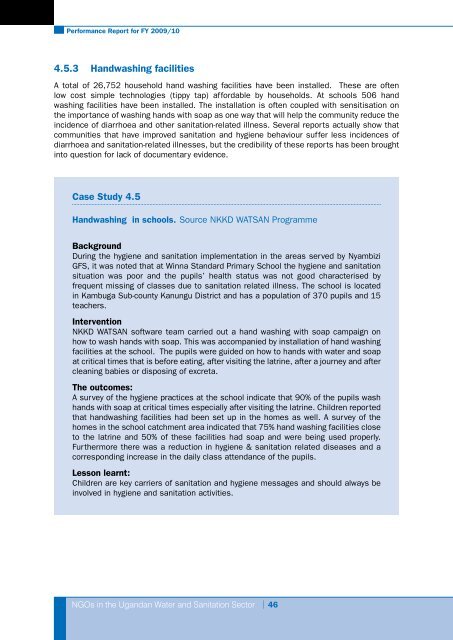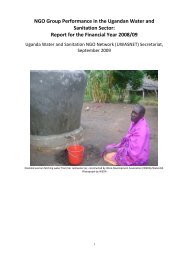Performance Report for FY 2009/10 - UWASNET
Performance Report for FY 2009/10 - UWASNET
Performance Report for FY 2009/10 - UWASNET
Create successful ePaper yourself
Turn your PDF publications into a flip-book with our unique Google optimized e-Paper software.
<strong>Per<strong>for</strong>mance</strong> <strong>Report</strong> <strong>for</strong> <strong>FY</strong> <strong>2009</strong>/<strong>10</strong><br />
4.5.3 Handwashing facilities<br />
A total of 26,752 household hand washing facilities have been installed. These are often<br />
low cost simple technologies (tippy tap) af<strong>for</strong>dable by households. At schools 506 hand<br />
washing facilities have been installed. The installation is often coupled with sensitisation on<br />
the importance of washing hands with soap as one way that will help the community reduce the<br />
incidence of diarrhoea and other sanitation-related illness. Several reports actually show that<br />
communities that have improved sanitation and hygiene behaviour suffer less incidences of<br />
diarrhoea and sanitation-related illnesses, but the credibility of these reports has been brought<br />
into question <strong>for</strong> lack of documentary evidence.<br />
Case Study 4.5<br />
Handwashing in schools. Source NKKD WATSAN Programme<br />
Background<br />
During the hygiene and sanitation implementation in the areas served by Nyambizi<br />
GFS, it was noted that at Winna Standard Primary School the hygiene and sanitation<br />
situation was poor and the pupils’ health status was not good characterised by<br />
frequent missing of classes due to sanitation related illness. The school is located<br />
in Kambuga Sub-county Kanungu District and has a population of 370 pupils and 15<br />
teachers.<br />
Intervention<br />
NKKD WATSAN software team carried out a hand washing with soap campaign on<br />
how to wash hands with soap. This was accompanied by installation of hand washing<br />
facilities at the school. The pupils were guided on how to hands with water and soap<br />
at critical times that is be<strong>for</strong>e eating, after visiting the latrine, after a journey and after<br />
cleaning babies or disposing of excreta.<br />
The outcomes:<br />
A survey of the hygiene practices at the school indicate that 90% of the pupils wash<br />
hands with soap at critical times especially after visiting the latrine. Children reported<br />
that handwashing facilities had been set up in the homes as well. A survey of the<br />
homes in the school catchment area indicated that 75% hand washing facilities close<br />
to the latrine and 50% of these facilities had soap and were being used properly.<br />
Furthermore there was a reduction in hygiene & sanitation related diseases and a<br />
corresponding increase in the daily class attendance of the pupils.<br />
Lesson learnt:<br />
Children are key carriers of sanitation and hygiene messages and should always be<br />
involved in hygiene and sanitation activities.<br />
NGOs in the Ugandan Water and Sanitation Sector | 46



